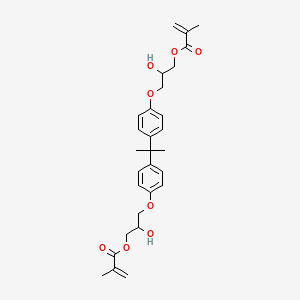D0806 | bisphenol a glycidyl methacrylate
| Toxicity | Dose | Time | Species | Model | Method | Action | Positive criterion | Reference |
|---|---|---|---|---|---|---|---|---|
| MEMBRANE POTENTIAL | 12.20±11.86 | human | qHTS-HepG2 | MMP assay | decrease | IC50 | 163 | |
| MEMBRANE POTENTIAL | 15.85 | human | HepG2 | MMP assay | decrease | IC50 | 163 | |
| MEMBRANE POTENTIAL | 38.15±9.22 | rat | hepatocytes | MMP assay | decrease | IC50 | 163 | |
| Pictogram | Signal | Statements | Precautionary Statement Codes |
|---|---|---|---|
  |
Danger |
Aggregated GHS information provided by 174 companies from 9 notifications to the ECHA C&L Inventory. Each notification may be associated with multiple companies. Reported as not meeting GHS hazard criteria by 4 of 174 companies. For more detailed information, please visit ECHA C&L website Of the 8 notification(s) provided by 170 of 174 companies with hazard statement code(s): H315 (71.18%): Causes skin irritation [Warning Skin corrosion/irritation] H317 (76.47%): May cause an allergic skin reaction [Warning Sensitization, Skin] H318 (23.53%): Causes serious eye damage [Danger Serious eye damage/eye irritation] H319 (71.76%): Causes serious eye irritation [Warning Serious eye damage/eye irritation] Information may vary between notifications depending on impurities, additives, and other factors. The percentage value in parenthesis indicates the notified classification ratio from companies that provide hazard codes. Only hazard codes with percentage values above 10% are shown. |
P261, P264, P272, P280, P302+P352, P305+P351+P338, P310, P321, P332+P313, P333+P313, P337+P313, P362, P363, and P501; (The corresponding statement to each P-code can be found at the GHS Classification page.) |
| (1-Methylethylidene)bis(4,1-phenyleneoxy(2-hydroxy-3,1-propanediyl)) bismethacrylate | (1-methylethylidene)bis[4,1-phenyleneoxy(2-hydroxy-3,1-propanediyl)] bismethacrylate | 12704-74-4 |
| 1565-94-2 | 2,2-Bis[4-(2-hydroxy-3-methacryloxypropoxy)phenyl]propane | 2-Propenoic acid, 2-methyl-, (1-methylethylidene)bis(4,1-phenyleneoxy(2-hydroxy-3,1-propanediyl)) ester |
| 2-Propenoic acid, 2-methyl-, (1-methylethylidene)bis(4,1-phenyleneoxy(2-hydroxy-3,1-propanediyl)) ester, homopolymer | 2-Propenoic acid, 2-methyl-, (1-methylethylidene)bis[4,1-phenyleneoxy(2-hydroxy-3,1-propanediyl)] ester | 2-Propenoic acid, 2-methyl-, 1,1'-((1-methylethylidene)bis(4,1-phenyleneoxy(2-hydroxy-3,1-propanediyl))) ester |
| 2-Propenoic acid, 2-methyl-, 1,1'-[(1-methylethylidene)bis[4,1-phenyleneoxy(2-hydroxy-3,1-propanediyl)]] ester | 30757-19-8 | 83382-93-8 |
| ACM24447721 | ACN-051743 | AKOS015903791 |
| AMFGWXWBFGVCKG-UHFFFAOYSA-N | Adaptic | BISPHENOL A DIGLYCIDYL DIMETHACRYLATE |
| BISPHENOL A-GLYCIDYL METHACRYLATE | BRN 2316426 | Bis(Phenol A-Glycidyl Methacrylate), Homopolymer |
| Bis-GMA Polymer | Bis-gma | Bisphenol A Glycidyl Methacrylate |
| Bisphenol A diglycidyl methacrylate | Bisphenol A glycerolate dimethacrylate | Bisphenol A glycerolate dimethacrylate, glycerol/phenol 1; |
| Bisphenol A glycidylmethacrylate | Bisphenol A-diglycidyl-dimethyl acrylate | Bisphenol(a)glycidylmethacrylate |
| C14511 | CAS-1565-94-2 | CCRIS 8222 |
| CHEBI:34580 | CHEMBL1600257 | Concise Enamel Bond |
| DSSTox_CID_24841 | DSSTox_GSID_44841 | DSSTox_RID_80521 |
| DTXSID7044841 | EINECS 216-367-7 | Enamel Bond, Concise |
| Epoxylite 9075 | HMS2232M17 | LS-123696 |
| MLS001333623 | MLS001333624 | NCGC00247011-01 |
| NCGC00256180-01 | Nupol 1629 | Nupol 46-4005 |
| NuvaSeal | Panavia opaque | Poly(Bis-GMA) |
| Q27116161 | Retroplast | SCHEMBL15349 |
| SMR000857281 | Silux | Tox21_301683 |
| [2-hydroxy-3-[4-[2-[4-[2-hydroxy-3-(2-methylprop-2-enoyloxy)propoxy]phenyl]propan-2-yl]phenoxy]propyl] 2-methylprop-2-enoate | isopropylidenediphenyl bisoxyhydroxypropyl methacrylate |
| CAS Number | 12704-74-4, 1565-94-2, 24447-72-1, 30757-19-8, 83382-93-8 |
| PubChem Compound | 15284 |

